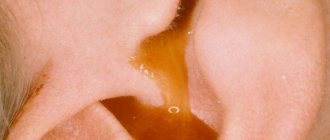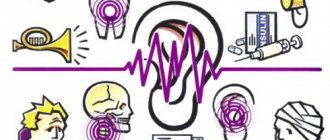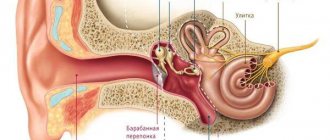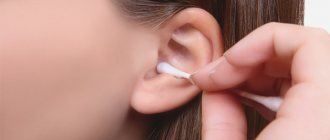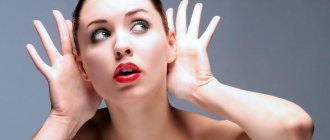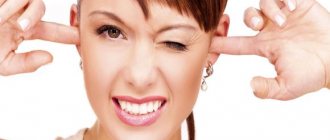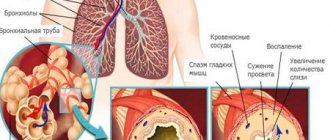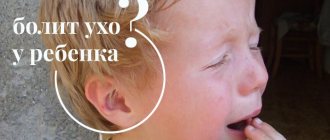If the ears are peeling inside or outside, this is a sign of an epidermal rejection disorder. Dryness in the ears, any redness, the appearance of small wounds, scabies, flaking - these symptoms indicate neglect of hygiene standards or the development of a disease that will subsequently cause even greater trouble. And if the problem is a developing disease, ignoring it is very dangerous.
Local allergies
This is a common cause of dry ears. Problems with the skin of the ears appear after changing hygiene products, for example, shampoo. They occur when:
- wearing earrings made of inexpensive materials;
- changing gold jewelry to silver;
- constant use of headphones;
- wearing glasses with metal temples.
You may be interested in: Perforated otitis media: symptoms, diagnosis, treatment
In these cases, the problem is associated with a local allergy, which goes away after the irritant is eliminated. In advanced situations, drug treatment is performed. A specialist diet and the use of emollient ointments are required.
In addition to dry skin in the ears, allergies manifest themselves in the form of:
- slight redness of the epidermis;
- burning;
- itching.
To determine if there is an allergy, you need to change your shower product. For several days you should not wear earrings, headphones or glasses with metal arms. In the absence of timely treatment, there is a risk of complications - dermatitis of the outer ear or eczema.
Dandruff in the ears: features of manifestation
If the skin in your ears is flaking, then most likely it is just normal dandruff. Its occurrence is associated with dysfunction of the sebaceous glands, when either too much or very little subcutaneous sebum is secreted.
As with the area on the head, dead skin can peel off in and behind the ears, which is what appears as white flakes called dandruff.
Very often, dandruff is confused with ordinary flaking of the skin in the ears, which leads to improper treatment. If you always want to look neat, then compare the signs of dandruff with existing manifestations or seek help from a dermatologist or trichologist (specialist).
Signs of dandruff:
- Ear dandruff, unlike flaking, looks like white or yellowish flakes;
- the scale of dandruff is much more significant;
- regular exfoliation does not lead to itching, which cannot be said about dandruff;
- when you eliminate dry skin in the ears, redness of the skin under the film becomes noticeable;
- if you have dandruff, you constantly feel that there is a foreign body in your ears;
- in symbiosis with otitis media, it can cause ear congestion and hearing impairment.
Important point! Due to certain circumstances, psoriasis may develop on the skin in the ears and behind them, which is indicated not only by peeling, but by swelling and pink color of the skin. Do not treat the disease yourself, but rather seek competent help from specialists.
Ear skin fungus
You may be interested in: Ears hurt after an airplane: what to do? Stuffed ears on the plane
Because the organs are interconnected, painful signs may appear in the mouth. Dryness and noise in the ears are caused by fungus. This phenomenon is usually detected in those who strongly clean their ears with a special stick or rinse their ear canals with water, or use someone else’s headphones.
Another fungus manifests itself in the form of:
- periodic headaches;
- tinnitus;
- increasing itching;
- sulfur plug;
- liquid discharge from the ear canal.
Often the fungus manifests itself in the form of an infection that affects the general condition of the patient. This has an effect on increasing body temperature, performance and severe fatigue.
Peeling skin, itching in the ears inside and outside the auricles: causes
There are many reasons why there is itching and burning in the ear area. This can be either an allergic reaction or a symptom of a serious illness. Oddly enough, itchy ears can be associated with endocrine or hormonal disorders.
Causes of itching:
- Poor hygiene. Itching may occur if you clean your ears very often. In this case, the auditory canal is damaged. As the wounds heal, a burning sensation is observed.
- Allergy. It may be associated with flowering plants or the use of powders with strong odors. Food allergies cannot be ruled out.
- Otomycosis. This is a fungal disease, which in the initial stages is characterized by mild itching or a slight burning sensation.
- Dermatitis. It may be seborrheic or allergic. It all depends on what caused the illness.
Peeling skin, itching in the ears inside and outside the auricles: causes
Skin ailments
Dry ears and itching do not occur on their own. This is just one of the many symptoms that appear with skin ailments. Ear diseases include:
- Seborrheic dermatitis. Dandruff and white plaque appear in the ear and outside. There is itching, a feeling of discomfort, dryness occurs more with redness, itching, rash, and slight changes in the structure of the skin.
- Eczema. Redness, itching, rash, and slight changes in the structure of the skin appear.
- Ear psoriasis. Its main symptoms include patchiness, flaking and dryness. There is also redness around the ear canal and irritation.
- Folliculitis. This is an infection that manifests itself in the form of a rash on the ears, itching, and blisters.
- Furuncle. With this disease, pimples with pus appear in the ear. Pain, hearing loss, redness, congestion and swelling also occur.
Other reasons
Noise and dryness in the ears still appear from exposure to external factors. This often happens when:
- frequent stress;
- poor nutrition;
- violation of day and night regimes;
- failure to comply with hygiene rules;
- genetic predispositions or congenital ailments.
Whatever the reasons, dry ear causes a lot of inconvenience. A timely visit to a doctor can eliminate many different problems.
Inflammation of the outer ear or skin
You may be interested in: Inflammation of the eardrum: causes, symptoms and treatment
Dryness in the ear is very easy to recognize, since the symptoms of such ailments are as follows:
If these symptoms persist for more than two days and gradually intensify, experts advise seeking medical help. A full examination is required.
Systemic ailments
Dry ears and nose are associated with systemic diseases. Of the ear diseases, otitis media is often detected, which manifests itself in the form of:
In advanced situations, purulent discharge, shooting pain, fever, and hearing loss occur. If left untreated, otitis will negatively affect the parotid cartilage and bones, vestibular apparatus, and brain activity.
Skin problems, even in the ears, appear with diabetes. This appears in the form:
- slight odor of acetone;
- extreme thirst;
- irritation of the upper layers of the epidermis;
- rapid onset of fatigue;
- need for frequent visits to the restroom;
- itching and tingling sensations in the fingertips.
There is another systemic disease - liver pathology. In this case, in addition to peeling, itching and dryness in the ear, there is pain, fever, a feeling of bitterness in the mouth and bloating.
Causes of dandruff in the ears
The skin and sebaceous glands on the ears, secreting excess oil, provoke dandruff. The root of the problem is the fungus Pityrosporum. With increased oily skin, it begins to actively multiply. This fungus is always present in the natural microflora, but it is activated and affects the epidermis when the immune system is suppressed.
Provoking factors:
- insufficient or lack of ear hygiene;
- lack of vitamins and minerals in the diet;
- hormonal imbalance during pregnancy, menopause;
- metabolic disorders;
- hereditary predisposition;
- dry ears;
- previous otitis media or furunculosis;
- liver or digestive tract diseases;
- reaction to low-quality shampoo or soap.
Lack of hygiene is the main reason. In unwashed ears, the pores become clogged with oil, causing crusts to appear.
An unbalanced diet is the second reason. The appearance of dandruff is provoked by soda and fast foods, spicy, fatty and fried foods, large gaps between meals, vitamin deficiency, and dry snacks.
In addition, women are more susceptible to seborrhea due to frequent fluctuations in hormones.
Dandruff in the ear
Dandruff can appear in the ears, just like on the scalp. You can identify this problem by:
Dry ear should not be ignored. Folk remedies and traditional treatment will help eliminate the problem. Therapy should be carried out while observing daily hygiene, proper nutrition and taking vitamins: “Complivit”, “MultiTabs”, “Vitrum”.
Why do ears peel outside and inside?
Otitis
The infection can be caused by water getting into the ear canals, hypothermia, or damage to the skin.
Signs of developing otitis media:
- Itching in the depths of the ear, slight hearing loss, feeling of a “plug”.
- The progression of the disease leads to the appearance of pain, the release of purulent masses, which in turn entails dermatitis: the skin begins to itch, the ears peel off as a result of irritation.
Inflammatory processes should only be treated under the supervision of a specialist. For mild cases, solutions of boric acid are used; complex cases require taking antibiotics internally (Amoxiclav, Nitrofural), anti-inflammatory and antibacterial agents externally. Sometimes physiotherapy procedures are prescribed, for example, UHF and UV.
furuncle
Damaged skin is prone to inflammation. If infection occurs, a boil forms - an acute inflammation of the hair follicle, subcutaneous tissue and sebaceous glands. The onset of the pathological process is accompanied by itching of the skin, redness of the affected area, for example, behind the ears or directly in them. Hearing does not deteriorate, but swelling and pain occur, which intensifies from touching, chewing, or pulling on the auricle.
If external otitis, as a rule, is easily treated with conservative treatment, then in the case of a boil, surgical intervention is necessary. After this, there is a need for antibiotic therapy over a long period of time.
Dermatitis and eczema
The causes of peeling and irritation of the skin in the ears may be hidden in these diseases, which arise as a result of allergic reactions, due to mechanical irritation of the skin (eg construction dust), under the influence of secretions during the inflammatory process, in case of weakened immunity and in chronic pathologies that impair metabolism.
Dermatitis
The atopic form is characterized by itching around the ear canal, in the shell, and on the scalp. The skin turns red, blisters with serous contents appear on it.
After opening the latter, peeling and the formation of weeping and then dry crusts occur. The contact form of the disease manifests itself in a similar way, but swelling, as a rule, occurs only at the site of contact with the irritant.
Itching in adults and children is relieved with the help of antihistamines for internal and external use (tablets, ointments), and anti-inflammatory drops are prescribed, etc. "Sofradex", "Otipax"). It is also necessary to use emollient creams or drying ointments, depending on the condition of the flaky crusts.
eczema
The disease can occur in acute or chronic form. The acute process lasts about 3 weeks. At this time, the upper layers of the skin are affected. With adequate treatment, eczema is not prone to relapse. Otherwise, an infection gets into the healing tissue or the disease continues to progress, weakening the immune system and becoming chronic.
The first symptoms of eczema are redness and thickening of the skin of the ears, itching, which gets worse when scratched. Then a rash appears. In place of the burst bubbles, crusts form, cracks peel off from scratching.
Your doctor will do a thorough examination to differentiate eczema from a fungal infection. Remove crusts inside and outside with oil solutions. If the affected areas become wet, treat them with ether or alcohol, and use aerosols with Oxycort.
If the peeling is dry, treatment is prescribed with anti-inflammatory ointments, which in addition have a vasoconstrictor and antifungal effect. Such products should also include antibacterial substances. When the ears are very itchy, use topical remedies. The course of treatment lasts about a month and must be completed even if the symptoms have completely disappeared. This is necessary to prevent relapses and transition to a chronic form.
Diagnostics
When the first symptoms appear, you should contact an otolaryngologist. The doctor examines the affected area and reviews the patient's medical history. Based on the data obtained, a referral for testing is issued. If the peeling is very visible, a swab is taken from the ear to determine the presence of fungus.
To exclude other pathologies, a general blood test will be required. If this is not enough, additional diagnostics are performed. Before prescribing therapy, it is necessary to determine the cause of ear seborrhea. An experienced specialist examines all the information received and makes a final diagnosis.
How to treat dandruff in the ear
Before starting treatment, doctors pay attention to the skin type, cause and advanced stage of the disease. All patients are prescribed an individual course of treatment for ear dandruff.
If you have peeling in your ears, your doctor will prescribe the causes and treatment depending on the disease.
There are many products that remove dandruff, but not every product treats the cause of its appearance.
First, the cause of its appearance is eliminated, and then it is necessary to carry out antimicrobial therapy, cleanse the affected skin and reduce inflammation. Then vitamins and antihistamines are prescribed.
Medicines
Treatment for dry ears depends on the type of problem. The type of medication is prescribed based on the type of fungus. Usually in this case, drugs such as Nitrofugin, Econazole, and Pimafucin are prescribed.
To treat otitis, you need antibacterial drugs - Levomekol, Triderm. And if allergies occur, Diazolin or other tablets with a calming effect are prescribed.
Ointments and creams
The doctor may prescribe a pharmaceutical cream intended for the treatment of ear ailments. The following funds are in demand:
Detailed instructions are included with each medication. Before using the drug, you should familiarize yourself with the dosage and duration of treatment.
Folk remedies
Folk methods that help eliminate dry ear include:
Before using any folk remedy, it is advisable to consult a specialist. This will prevent harm to the body.
Preventing skin peeling in the ears
To minimize the risk of such a pathology, you must follow the recommendations:
- Cleaning the ear canals should be done very carefully, no more than once or twice a week.
- To remove excess wax, you need to use a regular cotton swab, but use it only on the outer part of the ear canal.
- If a person uses a hearing aid, the device must be regularly treated with an antiseptic and use ear drops.
- When swimming and bathing, you need to wear a cap; it will protect your ears from water.
- In frosty weather, wearing hats should not be neglected.
- Cold air in the shortest possible time can provoke an inflammatory process and otitis media, which is not at all easy to get rid of.
- You should not use someone else’s headphones, as they may cause infection from another wearer.
It is necessary to monitor your immunity and strengthen it. If the body is strong, it will be able to overcome the inflammatory process on its own; auxiliary measures will not be needed. To do this, it is recommended to monitor your diet and include as many fresh vitamins and fruits in your diet as possible.
Despite the fact that peeling in the ears most often goes away on its own and is not dangerous, sometimes such a symptom is still a sign of a serious pathology. That is why it is better not to risk your health and if severe peeling occurs, consult a doctor immediately.
A balanced diet is one of the main ways to prevent peeling. A sufficient amount of vitamins, microelements, minerals, and fiber allows you to maintain healthy skin.
In a situation where the ears itch and peeling appears, it is enough for a person to take a course of multivitamins or drugs that normalize the intestinal microflora. Various skin problems often arise due to dysbiosis.
Prevention of peeling ears consists of proper care for them. When removing wax, you should not penetrate deep into the ear canal with a cotton swab. Only the outer part is cleaned; special ear sticks with limiters are used. You should also not resort to this procedure too often. You need to make sure that water or foreign objects do not get inside the ear.
Protecting your ears from frost or direct sunlight will prevent the problem. To prevent fungal infections, you do not need to use someone else’s headphones or telephone headset. It is important to maintain your immune system, get proper rest, and try not to overwork.
Patients who comply with the treatment regimen quickly get rid of the problem. Medicines relieve inflammation, relieve itching, eliminate flaking, and accelerate the regeneration of damaged tissues. After treatment with appropriate medications, the skin behind the ear acquires a natural color and healthy appearance.
Dermatological disorders will not appear if you follow preventive measures:
- carry out hygiene procedures in a timely manner;
- eat rationally;
- consume sweets in limited quantities;
- do therapeutic exercises;
- do not be stressed.
Healthy skin has an intact surface layer, there are no cracks, keratinized particles, rashes, or crusts. If the epithelial tissues in the parotid zone are flaky, wet and itchy, these are alarming signals. If these negative signs appear, you should immediately visit a doctor.
Preventive methods for the occurrence of peeling and associated diseases include:
- exclusion of communication with potentially infected people and carriers of seborrhea, fungal infections and dermatitis;
- use of personal hygiene products;
- timely consultation with a doctor when the first symptoms appear;
- immune support;
- treatment of chronic diseases;
- exclusion of stressful situations;
- proper nutrition;
- maintaining regular hygiene rules.
If the skin near the ear or inside the ear canal peels, this does not always mean the presence of a serious pathology. On the other hand, a simple visit to the doctor takes a minimum of time, but it provides answers to the causes of symptoms. It is better to play it safe several times than to subsequently deal with the treatment of a serious infectious or fungal disease.
Precaution
To prevent the disease from appearing again, you need to follow the recommendations of dermatologists:
If dandruff in the ears is not treated, acute mycosis is likely to occur. The fungus acts locally and is also able to penetrate deep into the tissue. An integrated approach is used in the treatment of dandruff. At the same time, you need to eliminate the cosmetic problem with ointments, lotions and tablets.
Reasons for appearance
The question “why does dandruff form in the ears?” interests many. Thanks to numerous studies, it was possible to find out that dandruff is provoked by the fungus Pityrosporum, which begins to actively multiply in the event of malfunctions of the sebaceous glands.
The causes of white flakes in the ears can be:
- failure to comply with personal hygiene rules;
- unbalanced diet, in particular lack of vitamins and microelements;
- hormonal imbalances (adolescents and pregnant women often suffer from dandruff);
- metabolic disease;
- allergic reactions to cosmetics, household chemicals, jewelry and dust mites living in down pillows and blankets;
- excessive dryness in the ears;
- genetic predisposition;
- the appearance of otitis media and boils;
- gastrointestinal diseases and liver problems;
- incorrectly selected cosmetics - soap or shampoo.
As you can see, the track record is quite extensive. After diagnosis, your attending physician will help identify the causes of the disease and prescribe treatment that will not just eliminate the cosmetic problem, but will get rid of the root cause so that the disease does not begin to develop again.
Care and prevention
To preserve ears and skin, experts advise:
These recommendations will help eliminate dry skin in the ears. The main thing is not to ignore any symptoms and negative manifestations, and also to listen to the recommendations of your doctor.
Source
Treatment of itching and flaking in the ears
Treatment methods directly depend on what disease was diagnosed in the patient. Depending on the type of disease, the following treatment methods are used:
- Allergic reaction. Therapy for the patient begins after identifying an internal or external stimulus. To do this, you need to donate blood for allergens. If the result indicates that the body does not accept citrus fruits, tomatoes, eggs, etc., then all these products are excluded from the diet. The patient is prescribed antihistamines in tablets or in the form of intramuscular injections. The most commonly used are Suprastin, Claretin, Citrine, Ketotifen.
- Fungal infection. If the fungus penetrates into the inner cavity of the ear, treatment may take an indefinite period. As a rule, it is advisable to use not local ointments, but tableted drugs Ketoconazole, Lamisil, Fluconazole, Terbinafine, Itroconazole, Griseofulvin. Treatment of fungus inside the ear cavity is extremely important, since an untreated disease threatens not only peeling and itching, but also periodic inflammation.
- Chronic diseases. If you have diabetes, the primary goal is to control your blood glucose levels. For this, the patient is prescribed sugar substitutes. Depending on the type of disease, tablets that break down glucose or insulin are used to compensate for the lack of the pancreas' own hormone. Treatment of chronic otitis consists of the use of potent antibacterial medications and warming the ear area using electrophoresis.
At all stages of therapy, you need to monitor the cleanliness of the skin of the ear and prevent it from becoming dirty. It is recommended to wash your skin with warm water and soap 2 times a day, and then apply a moisturizing baby cream to it. This is the case if the skin is dry, it peels off and begins to itch very much.
